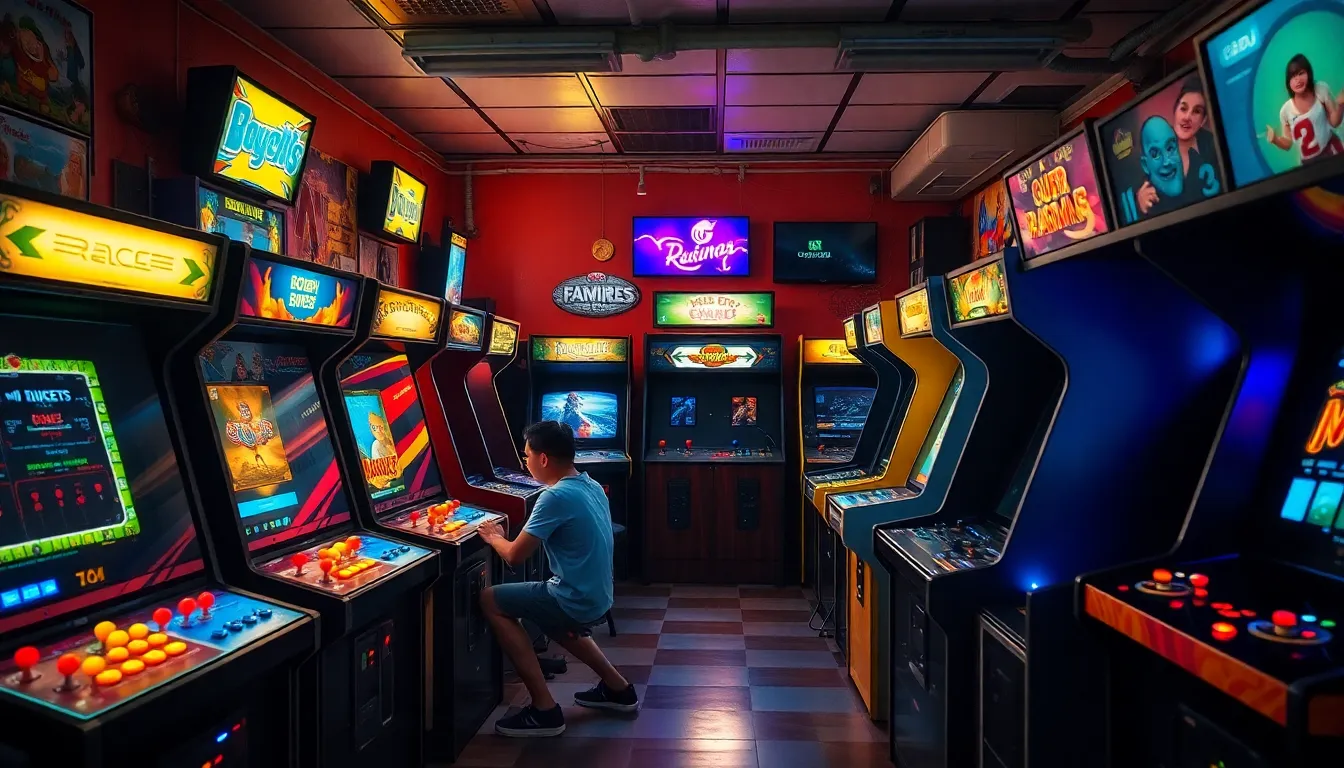Arcade gaming has evolved from simple pixelated screens to immersive experiences that captivate players of all ages. The buzz of coins dropping and the thrill of competition create an atmosphere that’s hard to replicate. As technology advances, so does the equipment that brings these games to life, making it essential for enthusiasts and operators alike to stay updated on the latest trends.
From classic cabinets to modern virtual reality setups, arcade gaming equipment encompasses a wide range of devices designed to enhance gameplay. Understanding the features and innovations in this space not only enriches the gaming experience but also helps in making informed purchasing decisions. Whether you’re a nostalgic gamer or a newcomer, exploring the world of arcade equipment can unlock endless entertainment possibilities.
Arcade Gaming Equipment
Arcade gaming equipment includes various devices designed to enhance the gaming experience in arcade settings. Classic cabinet games, such as Pac-Man and Space Invaders, utilize large screens and physical controls while celebrating nostalgia. Modern arcade machines offer an array of features, including high-definition displays, surround sound systems, and advanced control mechanisms that accommodate immersive gameplay.
Types of Arcade Equipment
- Cabinet Games: These traditional machines feature a protective shell housing a monitor, controls, and coin mechanisms. Popular examples include fighting games and racing simulators.
- Pinball Machines: These mechanical games rely on skill and luck, featuring flippers, bumpers, and scores based on gameplay speed.
- Redemption Games: These games reward players with tickets or prizes based on performance, often featuring bright visuals and engaging themes.
- Virtual Reality (VR) Systems: VR equipment provides an immersive gaming experience through headsets and motion sensors, allowing players to interact within virtual environments.
- Arcade Consoles: Standalone units allowing for multiple game downloads or streaming, suitable for home or commercial use.
Important Features
- Display Quality: The clarity and resolution of screens impact gameplay enjoyment. High-definition screens or LED technology enhance visual appeal.
- Control Systems: Reliable and responsive controls ensure a smooth gaming experience. Joysticks, buttons, and touchscreens vary in design and functionality.
- Sound Systems: Quality audio enhances immersion, with surround sound options elevating the atmosphere within games.
- Accessibility: Equipment designed for mobility can cater to players with disabilities, expanding inclusivity.
Understanding these aspects of arcade gaming equipment aids players in making informed decisions about their gaming experiences, whether in commercial arcades or at home. The diverse range of options available allows for customization to fit varying preferences and environments.
Types of Arcade Gaming Equipment


Arcade gaming equipment spans a variety of devices, each offering unique experiences. Understanding the different types facilitates an informed choice for any arcade enthusiast.
Classic Arcade Machines
Classic arcade machines define the gaming culture with their iconic designs and gameplay. They typically feature a stand-up cabinet with a joystick and buttons. Popular titles include Pac-Man, Donkey Kong, and Street Fighter II. These machines emphasize pixelated graphics and simple controls, appealing to nostalgia while providing straightforward gameplay experiences. Key characteristics include:
- Build Quality: Sturdy wooden cabinets ensure durability.
- Monitor Type: CRT screens provide authentic visuals, capturing the retro vibe.
- Game Variety: Options range from platformers to fighting games, catering to diverse preferences.
Modern Arcade Games
Modern arcade games showcase advancements in technology and gameplay diversity. These devices often integrate high-definition graphics, immersive sound systems, and innovative gameplay mechanics. Examples include dance machines, interactive shooting simulators, and virtual reality experiences. Notable features consist of:
- Display Quality: High-resolution screens deliver stunning visuals.
- Control Systems: Motion sensors and touchscreens enhance user interaction.
- Multiplayer Options: Many games permit multiple players, fostering social competition.
These advancements in arcade gaming equipment cater to both classic and new generations of gamers, ensuring captivating experiences for everyone involved.
Key Features to Consider
Understanding key features of arcade gaming equipment enhances decision-making for potential buyers. Focus on the following aspects to maximize gaming enjoyment.
Build Quality
Build quality significantly influences durability and performance. Materials, such as plywood or MDF (medium-density fiberboard), determine the cabinet’s resilience. Sturdy bases enhance stability during gameplay, while well-crafted buttons and joysticks improve responsiveness. A solid monitor setup with protective screens resists wear from consistent use. Overall, high build quality ensures a longer lifespan and fewer maintenance needs.
Game Variety
Game variety plays a crucial role in attracting diverse audiences. Classic arcade cabinets typically feature iconic games like Pac-Man and Donkey Kong, catering to nostalgia. Modern systems often provide an extensive library, including genre-spanning titles and updates for user engagement. Additionally, some equipment supports downloadable content, expanding game selection over time. A well-rounded collection caters to different preferences, enhancing the arcade experience and drawing in more players.
User Experience
User experience directly affects gameplay enjoyment. High-definition displays render vibrant graphics, while immersive sound systems enhance atmosphere. Controls must be user-friendly to accommodate both novices and seasoned gamers. Accessibility features are essential for inclusivity, ensuring that all players can participate. Responsiveness and intuitive layouts lead to a smoother gaming experience, helping maintain player interest and satisfaction over time.
Popular Brands in Arcade Gaming
Numerous brands shape the arcade gaming landscape, each offering unique equipment that appeals to various player preferences. Key brands include:
- Namco: Known for classics like Pac-Man and Tekken, Namco provides high-quality arcade cabinets renowned for their classic game selections and engaging gameplay mechanics.
- Sega: Famous for Sonic the Hedgehog, Sega produces a variety of arcade games, including racing and fighting genres, emphasizing innovative designs and technology.
- Atari: As a pioneer in arcade gaming, Atari offers nostalgic cabinets featuring timeless hits like Asteroids and Centipede, appealing to retro enthusiasts.
- Konami: Recognized for popular franchises such as Dance Dance Revolution and Metal Gear, Konami emphasizes a blend of traditional and modern gameplay in their arcade offerings.
- Raw Thrills: A newer but influential brand, Raw Thrills focuses on modern arcade experiences, delivering engaging multiplayer games like Fast & Furious and Jurassic Park.
- Ice: Specializing in redemption games, Ice creates interactive experiences, allowing players to win tickets or prizes through skill-based gameplay.
These brands contribute to the diverse and evolving arcade equipment market, ensuring players enjoy a range of gaming options that cater to varying tastes and interests.
Maintenance and Upkeep of Arcade Equipment
Regular maintenance and upkeep of arcade equipment ensure optimal performance and longevity. Following specific routines helps prevent breakdowns and enhances the gaming experience.
Cleaning Procedures
- Dust Removal: Dust accumulates on screens, control panels, and internal components. Regularly wipe surfaces with a microfiber cloth to maintain cleanliness.
- Ventilation Checks: Ensure air vents remain unobstructed. Clean dust from vents to prevent overheating and improve airflow.
- Glass Cleaning: Use glass cleaner to clean the screens for a clear view. Avoid abrasive materials that could damage the surface.
Component Inspection
- Electrical Connections: Frequently check wiring for wear and loose connections. Tighten and replace damaged wires to prevent electrical issues.
- Joystick and Button Functionality: Test each joystick and button for responsiveness. Replace faulty components as soon as issues arise to ensure optimal gameplay.
- Software Updates: Regularly update game software and operating systems. Updates can enhance security, fix bugs, and improve gameplay features.
Hardware Maintenance
- Lubrication: Apply lubricant to moving parts of joysticks and mechanisms. Proper lubrication reduces wear and ensures smooth operation.
- Monitor Calibration: Calibrate monitors periodically for optimal display quality. Adjust brightness, contrast, and color settings for the best visual experience.
- System Cooling: Ensure internal fans function correctly. Replacing faulty fans prevents component overheating and prolongs equipment life.
Professional Servicing
- Scheduled Maintenance: Schedule professional servicing at least once a year. Technicians can provide comprehensive inspections and repairs that enhance performance.
- Parts Replacement: Replace worn-out or outdated components. Investing in new parts improves game reliability and overall experience.
By adhering to these maintenance practices, arcade operators and enthusiasts can keep their equipment in top condition, ensuring a fun and engaging environment for all players.
